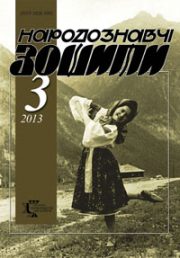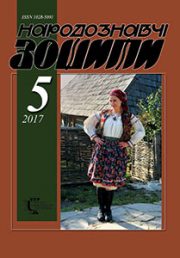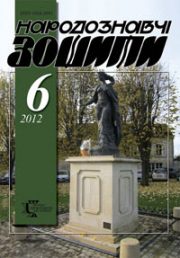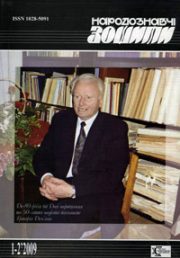The Ethnology Notebooks. 2019, № 5 (149), 1296—1304
UDK 08(477.46):37
DOI https://doi.org/10.15407/nz2019.05.1296
FOLK RITUAL «GOAT»: A TIME AND SPACE DIMENSION (BASED ON HISTORIC UMAN REGION)
YOVENKO Larysa
ORCID ID: https://orcid.org/0000-0003-1035-071X
Doctor of Pedagogical Sciences,
Associate Professor of Ukrainian Literature,
Ukrainian Studies and Teaching Methods Department
Pavlo Tychyna Uman State Pedagogical University
Garden street, 2, Uman, Tcherkasy area, 20300
e-mail: yovenko310@ukr.net
TERESHKO Іnna
ORCID ID: https://orcid.org/0000-0002-5682-7766
Candidate of Pedagogical Sciences,
Associate Professor of Choreography and Artistic Culture Department
Pavlo Tychyna Uman State Pedagogical University
Garden street, 2, Uman, Tcherkasy area, 20300
e-mail: art_dekanat@meta.ua
Abstract. The purpose of the article. The research is connected with the study of the ritual and mythological essence of the folk ritual drama «Goat» by the presentation of features of its existence in the historical Uman region (end of XIX — beg. of XXI centuries) and determination of forms of effective use of action in the educational process of modern higher educational institutions. The methodology of the study consists of the application of cultural studies, chronological-historical, expedition methods, as well as the method of the theoretical generalization.
The scientific novelty of the article is to expand the ideas about the folk ritual drama «Goat», to study its locally territorial features in the historical Uman region in the available scientific sources and materials of folklore and ethnographic expeditions of students and teachers of the Faculty of Ukrainian Philology of the Pavlo Tychyna Uman State Pedagogical University (1997—2018). Conclusions. The studied folk drama is the so-called a bypassing magic rite, the essence of which is to visit the houses for a specific ritual purpose. This rite reflects: 1) connection with nature, flora, fertility of the earth; 2) connection with the world of the dead; 3) magic (word magic, spells, imitative and contagious magic). The study of scientific works, archival materials of the Research Laboratory «Problems of Preparation of Future Philology Teachers for Ukrainian Studies at School» (Pavlo Tychyna Uman State Pedagogical University) showed that the traditional New Year’s performance of «Goat» in Uman region was peculiar, song, music and choreographic repertoire. It was in existence in the 1950s. A thorough study of regional folklore, folk dramatized forms of the native land during the educational process of higher education institutions has considerable potential in the formation of national and patriotic virtues of the individual, the development of professional competences of future teachers-philologists and art.
Keywords: folk theater, folk ritual drama, regional folklore, carols, choreographic behavior of brides, folk and ethnographic activity.
Received 29.10.2019
REFERENCES
New Ukrainian School. Conceptual principles of secondary school reform. Retrieved from:http://mon.gov.ua/activity/education/zagalna-serednya/ua-sch-2016 (Last accessed: 09.12.2017).
On Higher Education: Law of Ukraine dated 01.07.2014 № 1556- VII. Updated: 28.09.2017. Retrieved from: http://zakon2.rada.gov.ua/laws/show/1556-18 (Last accessed: 09.12.2017).
Afanasiev, A. (1982). Tree of Life: Selected Articles. Moscow: Sovremennyk [in Russian].
Baiburin, A.K. (1993). Ritual in traditional culture. Structural-semantic analysis of East Slavic rites. St. Petersburg: Nauka [in Russian].
Bakhtin, M. (2014). Creativity of Franзois Rabelais and the folk culture of the Middle Ages and the Renaissance. Moscow: Exmo [in Russian].
Veselovsky, A. (1989). Historical poetics. Moscow: Vysshaia Shkola [in Russian].
Gusev, V.E. (1967). Aesthetics of folklore. Leningrad: Nauka [in Russian].
Ivleva, L.M. (1997). Ryazhne in Russian traditional culture. Peterburg [in Russian].
Propp, V.Y. (1976). Folklore and reality. Selected articles. Moscow: Nauka [in Russian].
Borysenko, V. (2013) Traditional ethnic culture of Ukrainians in historical development. Folk creativity and ethnology, 5, 27—39 [in Ukrainian].
Davydiuk, V. (1997). The original mythology of Ukrainian folklore. Lutsk: Vezha [in Ukrainian].
Kylymnyk, S. (Ed.). (1994). The Ukrainian year in folk customs in historical coverage (Vol. 1). Kyiv: Oberehy [in Ukrainian].
Kurochkin, O. (1995). Ukrainian New Year Rites «Goat» and «Melanka» (from the history of folk masks). Opishne [in Ukrainian].
Petrov, V. (2013). Intelligence (Vol. 2.). Kyiv: Tempora [in Ukrainian].
Voropai, O. (1991). The customs of our people. Ethnographic Essay (Vol. 1). Kyiv: Oberih [in Ukrainian].
Domanytskyi, V. (1999). Modern carols and bounty (Imprint from the Memorial book of the Kyiv province for 1905). Folk creativity and ethnography, 1, 89—102 [in Ukrainian].
Syvachuk, N. (2003). Ukrainian children’s folklore: a textbook. Kyiv: Demiur [in Ukrainian].
Yashchurzhynskyi, Khr. (1898). Christmas Interlude (Goat). Kyevskaia Staryna, 10. 73—82 [in Ukrainian].
Uspensky, B.A. (1982). Philological researches in the field of Slavic antiquities. Moscow: Moscow Publishing House. Univ. [in Russian].
Petrov, V. (2013). Intelligence (Vol. 3). Kyiv: Tempora [in Ukrainian].
Vynohradova, L.N. (1982). Winter calendar poetry of the western and eastern Slavs. Genesis and typology of carols. Moscow: Nauka [in Russian].
Chicherov, V.I. (1957). Winter period of the Russian agricultural calendar of the XVI—XIX centuries (essays on the history of popular beliefs). Moscow [in Russian].
Vynohradova, L.N. (2000). The mythological tradition of the Slavs. Moscow: Indrik [in Russian].
Sukhyna, O. (2001). Coziness, Umansky district, Cherkasy region (recorded by Nataliia Tomenko, born in 1924. 3 June, 2001). Archive of the Research Laboratory «Problems of Preparation of Future Philology Teachers for Ukrainian Studies at School». F. 1. Op. 3. Od. save 113. Arc. 31—32 [in Ukrainian].
Hut, N. (2004). Legedzine, Talnivsky district, Cherkasy region (recorded from Kryzhanivska Marusya, 1928, and Drobot Paraska, 1927. 6 July, 2004). Archive of the Research Laboratory «Problems of Preparation of Future Philology Teachers for Ukrainian Studies at School». F. 1. Op. 3. Od. save 236. Arc. 17 [in Ukrainian].
Haishuk, T. (2006). Korzhova, Uman district, Cherkasy region. (recorded by Shevchenko Maria, born in 1921. 12 June, 2006). Archive of the Research Laboratory «Problems of Preparation of Future Philology Teachers for Ukrainian Studies at School». F. 1. Op. 3. Od. save 377. Arc. 65 [in Ukrainian].
Melnyk, L. (2014). Bachkurine, Monastyrische district, Cherkasy region (recorded by Shandra Maria, born in 1931. 14 June, 2014). Archive of the Research Laboratory «Problems of Preparation of Future Philology Teachers for Ukrainian Studies at School». F. 1. Op. 3. Od. save 517. Arc. 18 [in Ukrainian].







